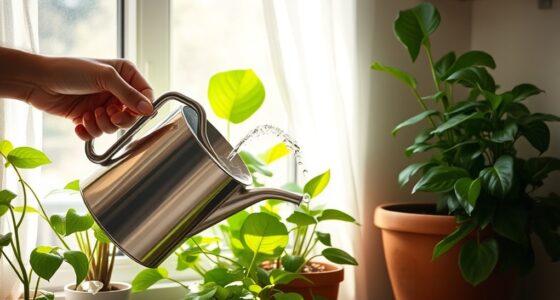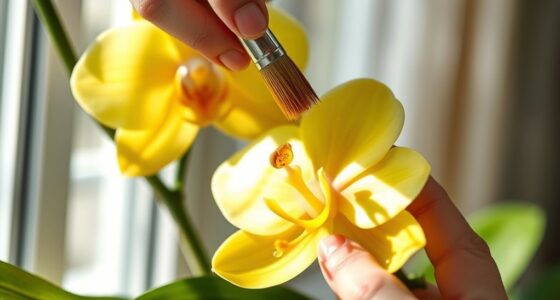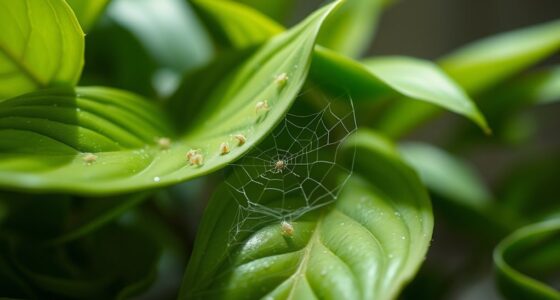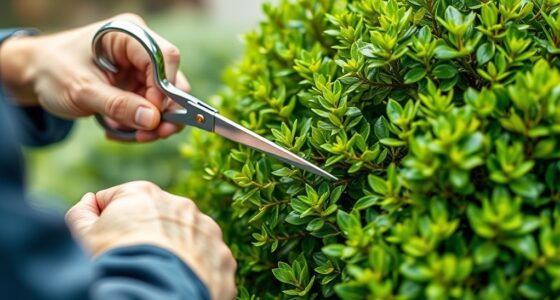The best time to water your indoor plants is in the morning. Cooler temperatures and higher humidity increase water absorption, helping your plants thrive. Morning watering reduces the risk of diseases and pests that can develop from excess moisture in the evening. Remember to consider your specific plant’s needs and adjust accordingly throughout the seasons. If you want to learn more about optimizing your plant care, there are a few helpful practices worth exploring.
Key Takeaways
- Water indoor plants in the morning to enhance water absorption and reduce disease risks.
- Avoid evening watering to minimize prolonged moisture retention that promotes fungal growth.
- Adjust watering frequency based on plant type, seasonal changes, and environmental conditions.
- Monitor soil moisture levels and plant health, watering when the top inch of soil feels dry.
- Use room temperature water and ensure pots have good drainage to prevent overwatering.
Importance of Morning Watering
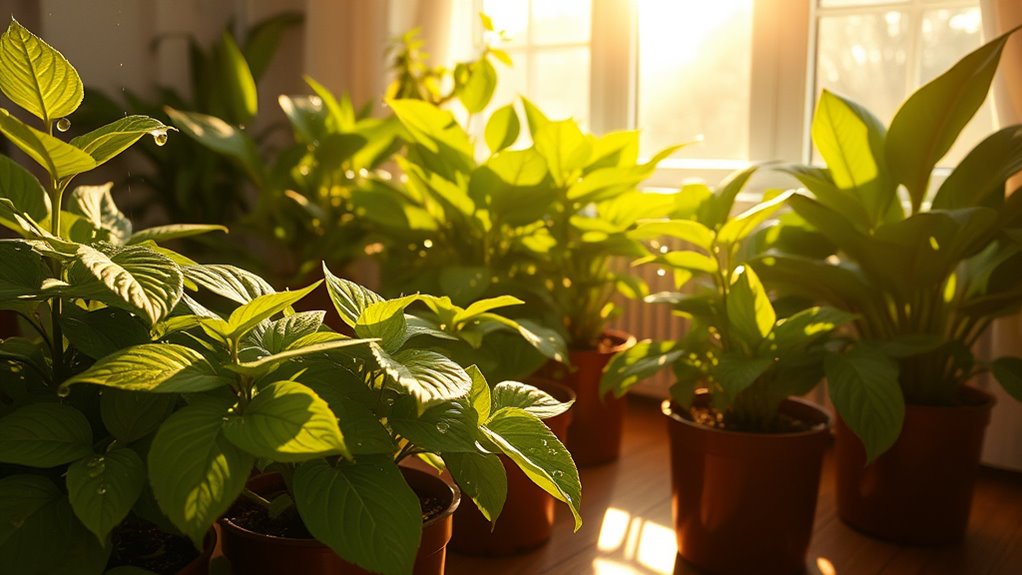
When you water your indoor plants in the morning, you set them up for success by taking advantage of optimal conditions for water absorption. The cooler temperatures and higher humidity enhance water uptake, ensuring more moisture reaches the roots. With lower wind speeds, there’s minimal evaporation, so your plants benefit fully from the water you provide. Plus, plant roots are most active in the morning, facilitating efficient nutrient transport and photosynthesis initiation. This routine not only supports growth but also keeps your plants vibrant and resilient. Morning watering significantly reduces the risk of diseases that thrive in damp conditions. Additionally, maintaining an organized space for your plants can further enhance their health by promoting mindfulness and emotional well-being. Regular air purifier maintenance can also contribute to a healthier indoor environment for your plants. Incorporating effective relaxation techniques into your routine can further improve your overall well-being while caring for your plants.
Risks Associated With Evening Watering
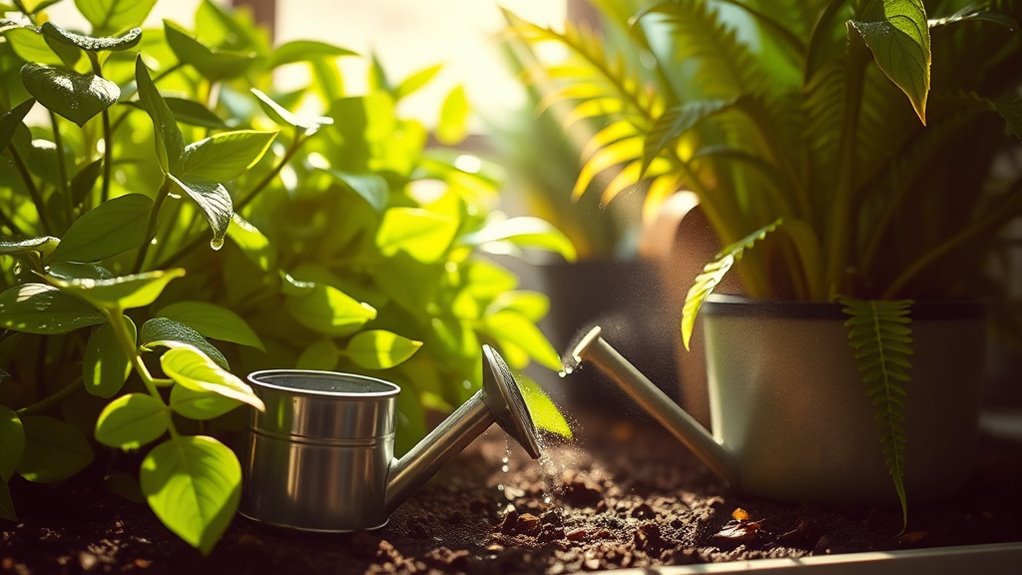
While morning watering offers many benefits, evening watering poses several risks that can jeopardize your indoor plants’ health.
Watering in the evening can create prolonged moisture retention, fostering fungal growth and diseases like powdery mildew. This damp environment also attracts pests, such as slugs and gnats, which can further harm your plants. Additionally, night watering increases the risk of fungal diseases due to damp conditions, making it crucial to be aware of this when considering your watering schedule. The presence of fungal diseases can lead to rapid deterioration of plant health, creating a cycle that is difficult to break. Moreover, newborn sunscreens can be crucial in protecting delicate skin from harmful UV rays, similar to how plants need protection from excess moisture-related issues. Furthermore, maintaining air quality is essential for overall plant health, as pollutants can weaken their resilience against infections.
Evening watering can lead to excess moisture, encouraging fungal growth and attracting harmful pests like slugs and gnats.
Additionally, overwatering becomes a concern, especially if you’re using an automatic irrigation system without proper monitoring. Without adequate ventilation and lower nighttime temperatures, soil remains saturated, limiting aeration and stressing your plants.
If you use cold water, it can stress roots even more. Overall, evening watering can lead to a cascade of issues, making your indoor plants more vulnerable to pests and diseases.
Factors Influencing Watering Time
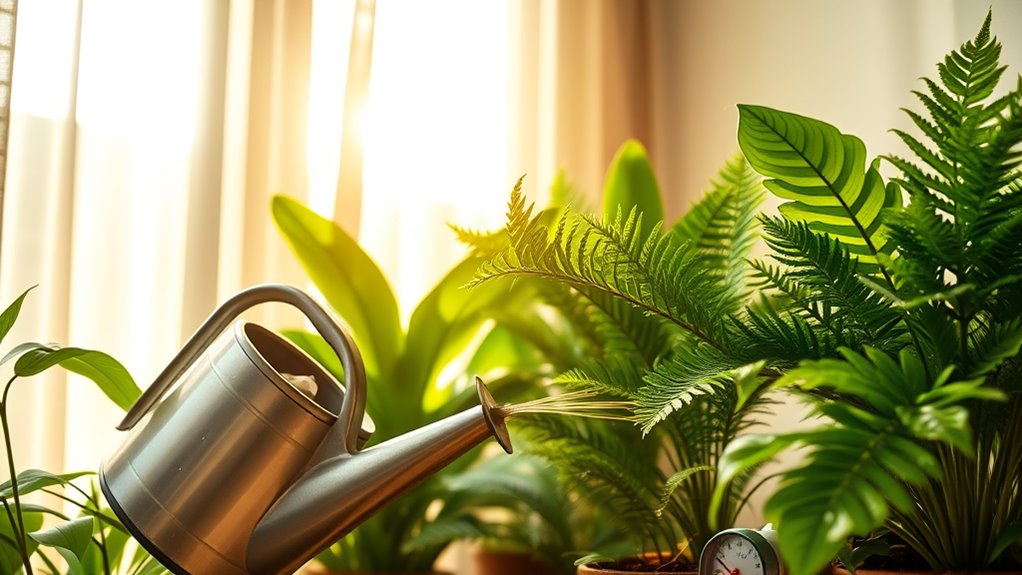
Understanding the various factors influencing watering time is crucial for maintaining healthy indoor plants. The type of plant you have matters; succulents and cacti thrive with infrequent watering, while tropical plants like Peace Lilies need consistent moisture. Additionally, understanding plant water needs is essential to ensure that you provide the right amount of hydration tailored to each species. Incorporating chia seeds into your plant care routine can also enhance moisture retention in the soil.
Environmental conditions also play a role—brighter spots demand more frequent watering due to quicker soil drying, while high humidity slows it down. Larger plants, for instance, typically require more water due to their increased leaf surface area. Seasonal changes affect needs too; expect more water during spring and summer. Energy efficiency ratings can be useful when selecting indoor plant care products, as they help identify options that consume less energy. Soil type and pot material can influence moisture retention, so choose well-draining soil and pots with drainage holes. Lastly, keep an eye on signs of underwatering or overwatering to adjust your schedule accordingly.
Tailoring your approach ensures your plants stay vibrant and healthy.
Benefits of Morning Watering
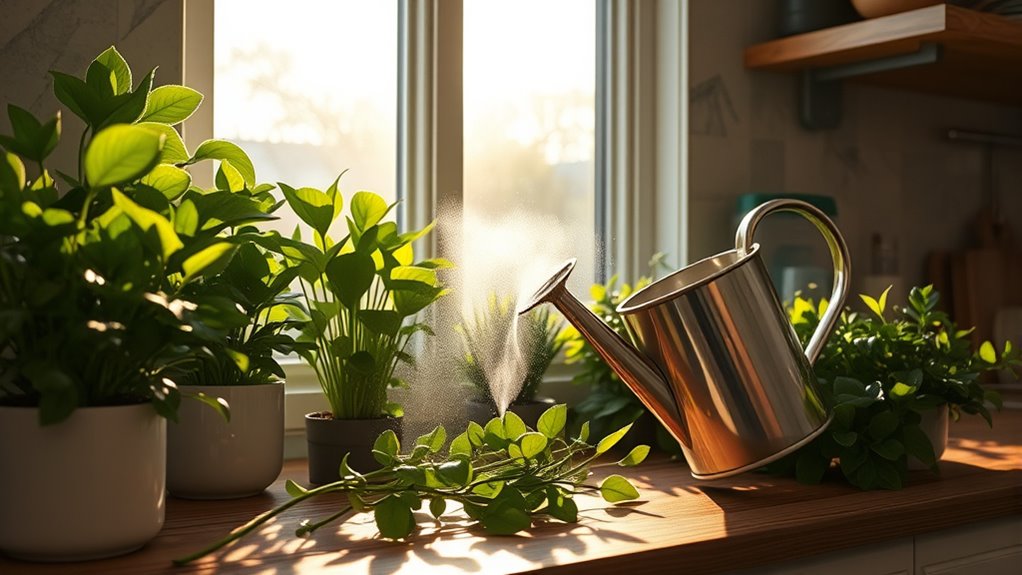
Watering your indoor plants in the morning offers numerous benefits that can significantly enhance their health.
With lower temperatures, water penetrates deeper into the soil before evaporating, optimizing absorption. Morning watering also reduces the risk of diseases like powdery mildew, as excess moisture evaporates throughout the day. This timing aligns with your plants’ natural photosynthesis cycle, improving their growth. Additionally, roots are more active in the morning, allowing for better water uptake. This practice of watering in the morning also helps prevent over-saturation and ensures that roots receive adequate moisture. Furthermore, maintaining proper water levels can help avoid problems such as root rot caused by overwatering. Regularly providing your plants with adequate moisture is crucial for their overall health and resilience, as it mimics the natural budgeting of resources that plants require to thrive.
You’ll also minimize pest attraction, as a damp environment can invite unwanted visitors like slugs.
Adjusting Watering Based on Plant Needs

Morning watering sets a solid foundation for your plants, but recognizing their individual needs is just as important for their overall health. Baked kale, for instance, retains essential nutrients that can benefit both your diet and the environment. Additionally, starting your day with a protein-rich breakfast, like Egg Rollup and Dumpling Sauce, can provide you with the energy needed for proper plant care.
Succulents and cacti thrive on less water, while foliage plants typically need watering every 5-10 days. Soil moisture levels should be monitored to ensure optimal hydration for all types of plants. A raw food diet often emphasizes fresh, unprocessed ingredients, which can inspire healthier choices for your indoor plant care.
Peace lilies prefer moist soil, so water when the top inch feels dry. It’s worth noting that a flexitarian diet encourages variety, which can also inspire your indoor plant choices.
Be cautious with orchids; they often need less water unless conditions are dry. Environmental factors play a big role—bright light and warmer temperatures increase water requirements, and low humidity speeds up drying.
Regularly check for soil dryness, drooping leaves, and soil shrinkage to assess needs. Adjust your schedule based on seasonal changes and specific plant types to ensure they thrive.
Additional Care Practices for Indoor Plants
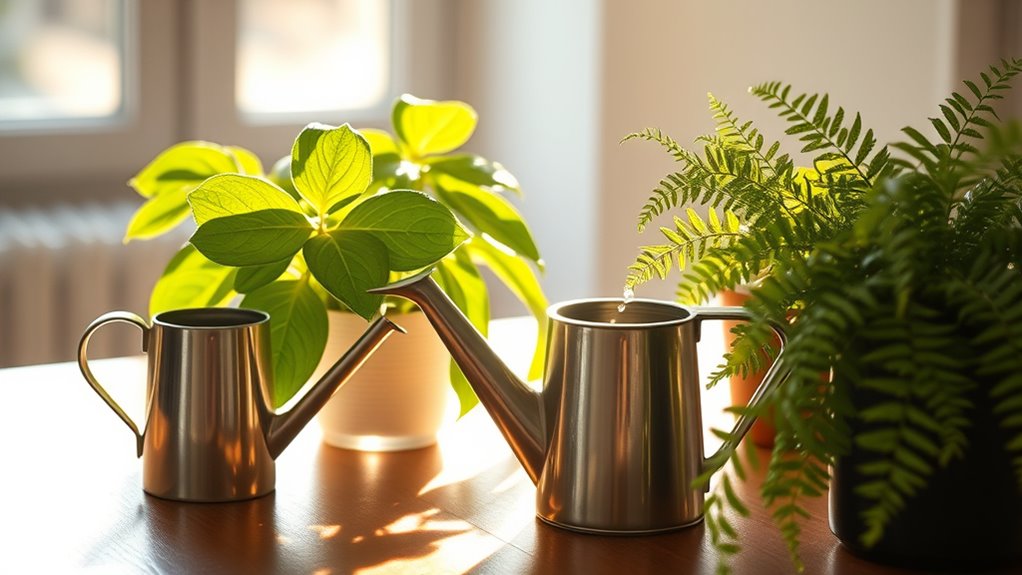
To keep your indoor plants thriving, it’s essential to adopt additional care practices that address their unique needs.
First, maintain optimal temperatures between 65°F and 85°F, avoiding cold drafts and heating vents. Higher contrast ratios can be beneficial for certain plants as they help in better light absorption. Additionally, understanding proper disposal methods for plant care waste can contribute to a healthier environment. Regular monitoring of heat pump efficiency can also inform your choices for creating a suitable indoor climate.
Check soil moisture before watering to prevent overwatering, and ensure your pots have good drainage. Always keep temperatures stable to ensure your plants remain happy and healthy.
Many tropical plants enjoy higher humidity, so mist them or use a humidifier as needed.
Regularly inspect for pests and prune to promote healthy growth.
Clean leaves to improve air quality and photosynthesis.
When repotting, use a quality potting mix and replace soil to provide fresh nutrients.
Lastly, fertilize during the growing season, but be careful not to overfertilize, as it can harm your plants.
Seasonal Variations in Watering Requirements
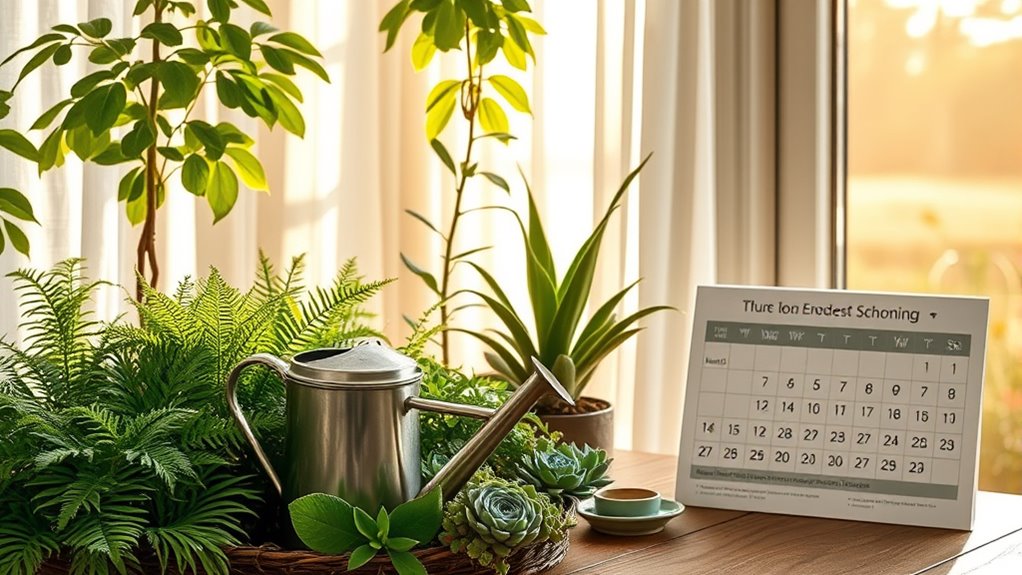
As the seasons change, so do your indoor plants’ watering needs. In spring and summer, the increased sunlight and warmth mean you’ll need to water more frequently, especially for moisture-loving plants. Aim to water these weekly, while low-maintenance varieties can be watered every two weeks. Incorporating natural materials like wood in your plant display can also enhance the aesthetic appeal of your indoor space. Additionally, creating a personalized work environment can help you enjoy your plant care routine as part of a fulfilling home office setup.
It’s also essential to consider that plants with emotional sensitivity, similar to individuals with BPD traits, may exhibit stress responses to inconsistent watering schedules. Come fall and winter, cooler temperatures and reduced growth require you to cut back on watering to prevent root rot—only water when the top two inches of soil feel dry. During this time, it’s important to remember that plants enter a period of dormancy, which affects their overall water requirements.
Keep in mind that factors like the type of plant, soil moisture, and container material also play a role. Always use room temperature water, water deeply, and monitor soil moisture to maintain healthy plants throughout the year.
Frequently Asked Questions
How Do I Know if My Plant Needs Water?
To know if your plant needs water, check for dry, brown edges on leaves or drooping foliage.
Stick your finger into the soil; if it feels hard and compact, it’s time to water.
You might also notice slow growth or leaf drop.
Use a moisture meter for accuracy or lift the pot to gauge its weight.
Observing these signs ensures your plant stays healthy and hydrated!
What Time Is Best for Watering Specific Plant Types?
When you think about the best time for watering specific plant types, consider their unique needs.
Tropical plants thrive with frequent watering, often in the morning.
Succulents and cacti prefer less frequent watering, so check the soil dryness before you water.
Moisture-loving plants enjoy consistent moisture, requiring regular attention.
Always adjust based on environmental factors like light and temperature to ensure your plants stay healthy and hydrated throughout the year.
Can I Use Tap Water for My Indoor Plants?
Can you really use tap water for your indoor plants? The answer isn’t straightforward.
While many people do, it’s essential to consider what’s in your water. Chlorine and fluoride can harm their health over time, but allowing it to sit for 24 hours can help.
Alternatively, think about using rainwater or filtered options for a safer choice. Your plants deserve the best, so choose wisely for their thriving!
Should I Water My Plants if It’s Cloudy?
If it’s cloudy, you should still check the soil moisture before watering your plants.
Cloudy weather doesn’t change their water needs; it just affects light levels. If the soil feels dry, go ahead and water, but avoid overwatering since excess moisture can lead to root rot.
Remember, maintaining a consistent watering routine is key, so keep monitoring your plants’ health and adjust accordingly.
Your green friends will appreciate your attention!
How Often Should I Water During Winter Months?
Imagine you’ve got a beautiful peace lily that usually flourishes in spring.
During winter, though, you’ll need to water it less frequently. Check the soil moisture every week; if it’s dry an inch deep, give it a drink.
Typically, every two to three weeks works well, but adjust based on your plant’s specific needs and the indoor humidity.
Watch for signs of overwatering, like yellowing leaves, to keep your peace lily thriving.
Conclusion
When you embrace the morning sun to water your indoor plants, you’re not just quenching their thirst; you’re gifting them a gentle start to their day. This tender ritual nurtures their growth and keeps them vibrant, while avoiding the shadows of evening risks. Remember, each plant has its own preferences, so listen closely and adjust as needed. By tuning into their needs and the seasons, you’ll cultivate a lush indoor oasis that thrives with life.




